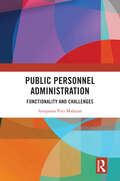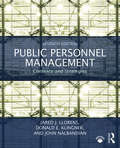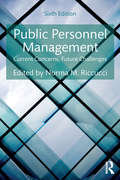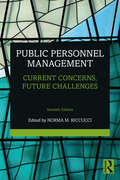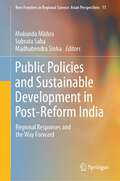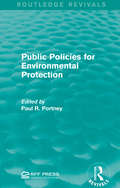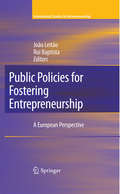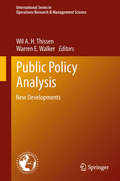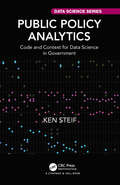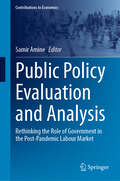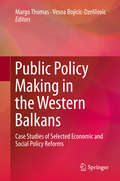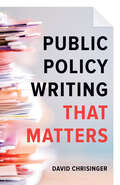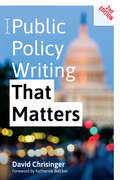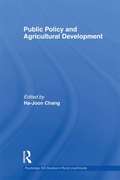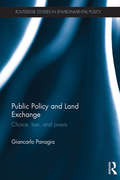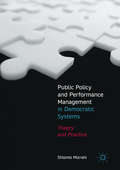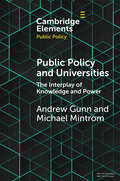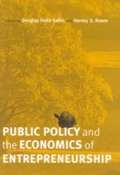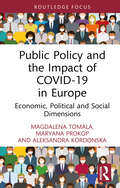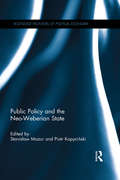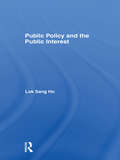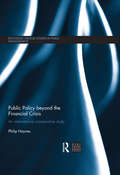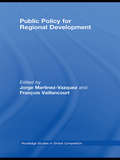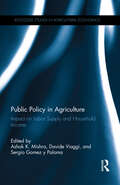- Table View
- List View
Public Personnel Administration: Functionality and Challenges
by Anupama Puri MahajanThis book addresses the processes and concerns within the purview of public personnel administration which is the key to success in carrying out governmental responsibilities and duties. With special focus on Indian administrative system, this volume probes into how public personnel administration is a critical aspect of the public sector that involves enhanced management of human resources. It also studies the evolution of public personnel administration in countries like the USA, UK, France, and Germany. Besides discussing the personnel processes in the post pandemic age, the book also examines the challenges that governments face on a global level. This title will be useful to students, researchers and teachers of Public Administration, Public Policy, Political Science, and General Management. The book will also be an invaluable companion to the policymakers in the government sector as it will strengthen their conceptual understanding of the subject.
Public Personnel Management: Contexts and Strategies
by John Nalbandian Jared J. Llorens Donald E. KlingnerNow in a thoroughly revised 7th edition, Public Personnel Management focuses on the critical issues and common processes in the management of public sector personnel. In keeping with prior editions, the text centers on the core processes within public human resource management: strategic workforce planning, effective recruitment and retention, workforce development, and employee relations. Designed to further address the ways in which expectations for human resource managers have changed and developed in recent years, the 7th edition includes several new features and improvements: Substantially restructured, updated, and additional case studies and student exercises. Coverage of how the field of Public HRM has been influenced by the two most recent national recessions, economic downturns at the state and local level, privatization and contracting trends at all levels of government, the growing presence of millennial employees in the workplace, issues surrounding social media use within the workplace, the evolving goals of social equity and diversity, and the shifting role and influence of labor unions. Discussions of how the growth in information technology capabilities has influenced the major processes within HRM, from workforce analysis through big data analytics to the explosion in automated recruitment, assessment, and instructional technologies. For the first time, the text includes an online Instructor's Manual, PowerPoint slides, discussion questions, and suggestions for further reading to make it even easier to assign and use this classic text in the classroom. Providing the most up-to-date and thorough overview of the history and practice of public human resource management for both undergraduate and graduate students, Public Personnel Management, 7e remains the beloved text it ever was, ideal for introductory courses in Public Personnel Management, Public Human Resource Management, and Nonprofit Personnel Management.
Public Personnel Management: Current Concerns, Future Challenges
by Norma M. RiccucciPublic Personnel Management has served as an essential, concise reader for public personnel and human resource management courses in the fields of public administration, political science, and public policy over the last 25 years. Since the first edition published in 1991, the book has offered professors and students alike an in-depth look at cutting-edge developments beyond standard textbook coverage, to provide a broad understanding of the key management and policy issues facing public and nonprofit HRM today. Original chapters are written expressly for the text by leading public administration scholars, each focusing on specific and often controversial concerns for public personnel management, such as pensions, gender and sexuality, healthcare, unions, and a multi-generational workforce. Now in an extensively revised sixth edition, Public Personnel Management presents new, original chapters to examine developments of interest to researchers and practitioners alike, including: remote working, cybersecurity, public service motivation, the abandonment of traditional civil service at the state and local levels, the Affordable Care Act and its implications for practice, pension systems and labor relations, affirmative action, social equity, legislation surrounding LGBT rights, and – as the field of public personnel management becomes more internationalized – a chapter addressing public personnel management across Europe. This careful and thoughtful overhaul will ensure that Public Personnel Management remains a field-defining book for the next 25 years.
Public Personnel Management: Current Concerns, Future Challenges
by Norma M. RiccucciPublic Personnel Management has served as an essential, concise reader for public personnel and human resource management courses in the fields of public administration, political science, and public policy for more than 30 years. Since the first edition published in 1991, the book has provided professors and students alike with an in-depth look at cutting-edge developments beyond standard textbook coverage, to cultivate a broad understanding of the key management and policy issues facing public and nonprofit HRM today. Original chapters are written expressly for the text by leading public administration scholars, each focusing on specific and sometimes controversial concerns for public personnel management, such as social equity, labor relations, public employee rights, and the operation of nonprofits. Now in an extensively revised seventh edition, Public Personnel Management presents new, original chapters to examine developments of interest to researchers and practitioners alike, including: new ways of working (NWW), remote work, the effects of the COVID-19 pandemic on public service workforces, work-life balance, patterns of discrimination and employees’ perceptions of fairness, affirmative action, generational differences in the workforce, and – as the field of public personnel management becomes more internationalized – chapters addressing human resource management across Europe and a chapter NWW practices in Switzerland. These, together with other chapters, ensure that Public Personnel Management will remain a field-defining book for the next 30 years.
Public Policies and Sustainable Development in Post-Reform India: Regional Responses and the Way Forward (New Frontiers in Regional Science: Asian Perspectives #71)
by Mukunda Mishra Subrata Saha Madhabendra SinhaThis book portrays India as a representative of post-colonial democratic republic states with a parliamentary form of federal-structured government and analyzes the critical challenges faced by such states in generating broadly shared economic well-being and quality of life. The reader is shown how creating and utilizing physical, human, financial, and social assets under the aegis of public policies help achieving the Sustainable Development Goals (SDGs) to provide a global framework to move toward a more equitable, peaceful, resilient, and prosperous society by 2030. It not only addresses how the state’s capacity has long been linked to the available economic resources, but also unfolds how the political system thus evolves to crucially determine the capacity of the state to implement its programs. The chapters of this book are particularly focused on judging the state’s capacity amid the neo-liberal ascendancy that has been triggered by the opening up of both the domestic and external economy, significantly initiated since 1991 and popularly known as the economic reforms in India.Examined here is the potency of the public policies of the country in fulfilling the sustainable development agendas, the specificity of which places the state at the heart of its execution, unlike many other versions of development that would be executed in parallel with or without states’ action. This work book has three principal foci facets within the broad swath of discussions covered by different chapters: (1) It critically examines how successful remains the public policies in mobilizing the population is mobilized to the next orbit of income, employment, education, and health consequent to amid the existing considerable magnitude of social and economic inequalities while achieving “equity” has always been the declared agenda in the post-reform public policy frameworks; (2) It traces the rationality of the transformation of the public policies and welfare strategies during the post-reform period in terms of motives, goals, and coverage to achieve the SDGs; and, (3) It reviews specific post-reform policies in terms of their potency to stimulate the system in addressing sustainable development. and upholding the state’s dominant and structuring intervention to resolve the existing inequalities and ensure that society develops amidst a harmonious world reconciled with nature.
Public Policies for Environmental Protection (Routledge Revivals)
by Paul R. PortneyOriginally published in 1990, this study tracks the issues, progress and problems in environmental issues in the United States from the 1980’s. Improvements in air and water quality as well as regulation of hazardous waste and toxic substances has led to new policies such as the Superfund Act and a general increase in awareness about environmental issues on a federal level. Placing an emphasis on economics, these papers analyse the effectiveness of environmental policy and progress made in relation to air pollution, water quality, hazardous wastes, toxic substances and enforcement of regulations. This title will be of interest to students of environmental studies.
Public Policies for Fostering Entrepreneurship
by Rui Baptista João LeitãoThe contribution of this book is to join in the same volume a set of theoretical visions and empirical assessments by leading scholars about public policies towards entrepreneurship in Europe and how to rethink them. The book is divided in two parts: Part I - Entrepreneurship Policies - A European Framework; and Part II - Entrepreneurship Policy in Countries and Regions. In Part I various theoretical approaches are presented by prominent scholars from around the world. They point to the need for the European economy to be the subject of regional reorganization, based on concentrations of production activities with a strong component of knowledge and technology. This book appears at a particularly challenging time, in economic and social terms, when entrepreneurship and innovation assume particular strategic importance, inasmuch as endogenous growth should be considered by policy-makers and also by business-people and citizens as one of the driving forces that can catalyze regional economies. The Entrepreneurship Policy examples contained in Part II from European countries in Scandinavia, Iberia, Germany, Turkey and the UK explore the implications for research, practice and policy-making in those regions.
Public Policy Analysis
by Warren E. Walker Wil A. ThissenTraditional policy analysis approaches are characterized by a focus on system modeling and choosing among policy alternatives. While successful in many cases, this approach has been increasingly criticized for being technocratic and ignoring the behavioral and political dimensions of most policy processes. In recent decades, increased awareness of the multi-actor, multiple perspective, and poly-centric character of many policy processes has led to the development of a variety of different perspectives on the styles and roles of policy analysis, and to new analytical tools and approaches - for example, argumentative approaches, participative policy analysis, and negotiation support. As a result, the field has become multi-faceted and somewhat fragmented. Public Policy Analysis: New Developments acknowledges the variety of approaches and provides a synthesis of the traditional and new approaches to policy analysis. It provides an overview and typology of different types of policy analytic activities, characterizing them according to differences in character and leading values, and linking them to a variety of theoretical notions on policymaking. Thereby, it provides assistance to both end users and analysts in choosing an appropriate approach given a specific policy situation. By broadening the traditional approach and methods to include the analysis of actors and actor networks related to the policy issue at hand, it deepens the state of the art in certain areas. While the main focus of the book is on the cognitive dimensions of policy analysis, it also links the policy analysis process to the policymaking process, showing how to identify and involve all relevant stakeholders in the process, and how to create favorable conditions for use of the results of policy analytic efforts by the policy actors. The book has as its major objective to describe the state-of-the-art and the latest developments in ex-ante policy analysis. It is divided into two parts. Part I explores and structures policy analysis developments, the development and description of approaches to diagnose policy situations, design policy analytic efforts, and policy process conditions. Part II focuses on recent developments regarding models and modeling for policy analysis, placing modeling approaches in the context of the variety of conditions and approaches elaborated in Part I.
Public Policy Analytics: Code and Context for Data Science in Government (Chapman & Hall/CRC Data Science Series)
by Ken SteifPublic Policy Analytics: Code & Context for Data Science in Government teaches readers how to address complex public policy problems with data and analytics using reproducible methods in R. Each of the eight chapters provides a detailed case study, showing readers: how to develop exploratory indicators; understand ‘spatial process’ and develop spatial analytics; how to develop ‘useful’ predictive analytics; how to convey these outputs to non-technical decision-makers through the medium of data visualization; and why, ultimately, data science and ‘Planning’ are one and the same. A graduate-level introduction to data science, this book will appeal to researchers and data scientists at the intersection of data analytics and public policy, as well as readers who wish to understand how algorithms will affect the future of government.
Public Policy Evaluation and Analysis: Rethinking the Role of Government in the Post-Pandemic Labour Market (Contributions to Economics)
by Samir AmineThis edited volume examines how some OECD countries have adapted to new challenges in the labor market by evaluating and analyzing public programs implemented before, during, and after Covid-19. To gain a comprehensive understanding, the volume adopts a multidisciplinary approach, with chapters contributed by authors from diverse disciplines and academic and professional backgrounds.
Public Policy Making in the Western Balkans
by Margo Thomas Vesna Bojicic-DzelilovicDeveloping and 'transition' economies face myriad challenges in their attempts to achieve and maintain political stability and foster the economic growth essential for national security, the social well-being of current citizens and sustainable environments for future generations. Governments in the Western Balkans have striven to achieve all of the above, and this volume assesses the nature of their experiences as well as the level of their success in doing so. Featuring detailed case studies of public policy reforms in the region as well as comparative analysis on a range of indicators, the book analyzes the role of key players in setting the political agenda as well as implementing policy reforms. It also distils the lessons that can be learned from the Western Balkan experience, recommending strategies for enhancing the policy making process. In addition, it examines the developmental role played by the full spectrum of policy actors, including the private sector, NGOs, special interest groupings, international financial institutions, donor nations and the EU. Each case study has been prepared by academics with deep knowledge and experience of the western Balkans and addresses a core set of questions: identifying the policy issue and its broader context, defining the roles of specific individuals in formulating policy and reform and assessing the influence of networks and coalitions in the policy making process. With so little detailed literature on public policy making in a group of nations strategically positioned between Europe, Russia and the near East, the detailed insights provided by this volume will be widely welcomed. Our book provides case studies of specific public policy reform episodes in selected Western Balkan post-conflict and transition countries. The focus of these case studies extends beyond the technical aspects and entails substantive examination of the policy actors, constituencies and politics that ultimately shape the policy that emerges from the policy making process. This analysis draws lessons for strengthening the quality of policies, the transparency, consistency, and governance of the policy making process and ultimately for contributing to economic and social development of the region.
Public Policy Writing That Matters
by David ChrisingerHone your public policy writing—and make a significant impact on the world.Students and professionals across a variety of disciplines need to write public policy in a manner that inspires action and genuine change. You may have amazing ideas about how to improve the world, but if you aren’t able to communicate these ideas well, they simply won’t become reality. In Public Policy Writing That Matters, communications specialist David Chrisinger argues that public policy writing is most persuasive when it tells clear, concrete stories about people doing things. Combining helpful hints and cautionary tales with writing exercises and excerpts from sample policy documents, Chrisinger teaches readers to craft concise, story-driven pieces that exceed the stylistic requirements and limitations of traditional policy writing.Too often, public policy writing is convoluted, opaque, and exclusive. Chrisinger, who teaches introductory policy writing courses around the country, offers a step-by-step guide for anyone interested in planning, organizing, developing, writing, and revising accessible public policy. From the most effective use of data visualization, the best way to write a sentence, and the ideal moment to add a compelling anecdote to advice on using facts to strengthen an argument, this little book, inspired by Strunk & White’s classic style guide, will allow anyone crafting public policy to make a bigger impact. Aimed at helping students and professionals overcome their default impulses to merely "explain," this book reveals proven, classroom-tested tips for writing sophisticated policy that is also easy to understand. This practical, concise handbook will not only aid students throughout graduate school but will also remain a reference to consult throughout their professional careers. A vital tool for any policy writer or analyst, Public Policy Writing That Matters is a book for everyone passionate about using writing to effect real and lasting change.
Public Policy Writing That Matters
by David ChrisingerA thoroughly updated and expanded guide to honing your public policy writing skills—and making a significant impact on the world.Professionals across a variety of disciplines need to write about public policy in a manner that inspires action and genuine change. You may have amazing ideas about how to improve the world, but if you aren't able to communicate these ideas well, they simply won't become a reality. In Public Policy Writing That Matters, communications expert David Chrisinger, who directs the Harris Writing Program at the University of Chicago and worked in the US Government Accountability Office for a decade, argues that public policy writing is most persuasive when it tells clear, concrete stories about people doing things. Combining helpful hints and cautionary tales with writing exercises and excerpts from sample policy analysis, Chrisinger teaches readers to craft concise, story-driven pieces that exceed the stylistic requirements and limitations of traditional policy writing.Aimed at helping students and professionals overcome their default impulses to merely "explain," this book reveals proven tips—tested in the real world and in the classroom—for writing sophisticated policy analysis that is also easy to understand. For anyone interested in planning, organizing, developing, writing, and revising accessible public policy, Chrisinger offers a step-by-step guide that covers everything from the most effective use of data visualization to the best ways to write a sentence, from the ideal moment for adding a compelling anecdote to advice on using facts to strengthen an argument. This second edition addresses the current political climate and touches on policy changes that have occurred since the book was originally published. A vital tool for any policy writer or analyst, Public Policy Writing That Matters is a book for everyone passionate about using writing to effect real and lasting change.
Public Policy and Agricultural Development (Routledge Iss Studies In Rural Livelihoods Ser.)
by Ha-Joon ChangThis book critically re-examines the currently dominant paradigm of agricultural development policy from historical and comparative perspectives. Examining the experiences of 11 developed countries in their earlier stages of development and the experiences of 10 developing and transition economies in the last half a century, the book offers an in-depth discussion on a range of public policies for agriculture, some currently in use and others forgotten in the mist of history. After presenting the overarching theoretical framework and a synthesis of findings over the 21 countries examined, the book presents six detailed case studies of agricultural policy in the last half a century in two Latin American countries (Chile and Mexico), two African countries (Ethiopia and Ghana), and two Asian countries (India and Vietnam). Each chapter examines a wide range of policies, including land policy (land tenure reform and land quality improvement), knowledge policy (research, extension, education, and information), credit policy (specialized banks and agricultural credit co-operatives), physical inputs policy (irrigation, transport, electricity, and divisible inputs such as fertilizers, seeds, and farm machinery), policies intended to increase farm income stability (price stabilization measures, insurances, and trade protection), and policies intended to improve agricultural marketing and processing. Through its historical and comparative approaches, the book frees our "policy imagination" by showing that the range of policies and institutions that have produced positive outcomes for agricultural development has been much wider than any particular ideological position – be it the pre-1980s statist one or the pro-market NCW – would admit. It also shows that the willingness to experiment with new policies and institutions, and the willingness to learn from other countries’ successes and improve upon their solutions, were important in all agricultural success stories.
Public Policy and Land Exchange: Choice, law, and praxis (Routledge Studies in Environmental Policy)
by Giancarlo PanagiaThis original contribution to the field is the first to bring economic sociology theory to the study of federal land exchanges. By blending public choice theory with engaging case studies that contextualize the tactics used by land developers, this book uses economic sociology to help challenge the under-valuation of federal lands in political decisions. The empirically-based, scholarly analysis of federal-private land swaps exposes serious institutional dysfunctions, which sometimes amount to outright corruption. By evaluating investigative reports of each federal agency case study, the book illustrates the institutional nature of the actors in land swaps and, in particular, the history of U.S. agencies’ promotion of private interests in land exchanges. Using public choice theory to make sense of the privatization of public lands, the book looks in close detail at the federal policies of the Bureau of Land Management and the U.S. Forest Service land swaps in America. These pertinent case studies illustrate the trends to transfer federal lands notwithstanding their flawed value appraisals or interpretation of public interest; thus, violating both the principles of equality in value and observance of specific public policy. The book should be of interest to students and scholars of public land and natural resource management, as well as political science, public policy and land law.
Public Policy and Performance Management in Democratic Systems
by Shlomo MizrahiThis book applies various theoretical tools to explore the advantages and disadvantages of performance management systems, the ways in which they can be improved, and the strategies through which they can be designed and integrated into the policy making process. By providing both theoretical insights and practical applications, it offers a unique perspective. Using four methods of research that have been rarely applied in the performance management literature: formal (game-theoretical) modelling, operational management, new institutionalism, and cross country statistical comparisons based on international data sets, the book illuminates different aspects of performance management systems in the public sector. It offers an integrative theoretical framework for explaining and designing such systems and their integration into the policy making process, and will open up new avenues of research, expose scholars and students to new methodological tools and equip public officials, politicians and citizens with practical methods for improving the performance of the public sector.
Public Policy and Universities: The Interplay of Knowledge and Power (Elements in Public Policy)
by Michael Mintrom Andrew GunnHigher education is undergoing unprecedented transformation. In the global knowledge economy universities are of paramount importance to governments worldwide. This creates a strong rationale for an element exploring how the interactions between universities and the state are being reconfigured, while highlighting the role policy analysis can play in explaining these dynamics. Specifically, this element draws on four theoretical approaches – New-Institutionalism, the Advocacy Coalition Framework, the Narrative Policy Framework, and Policy Diffusion and Transfer – to inform the analysis. Examples are drawn from a range of countries and areas of potential research informed by policy theory are identified. This element features a section dedicated to each of the three main missions of the university followed by an analysis of the institution as a whole. This reveals how universities, while typically seeking greater autonomy, remain subject to a multifaceted form of nation state oversight as they continue to globalise in an uncertain world.
Public Policy and the Economics of Entrepreneurship
by Douglas Holtz-Eakin Harvey S. RosenEntrepreneurship has been a subject of much recent discussion among academics and policymakers because of the belief that it invigorates the economy; producing greater productivity, more jobs, and higher economic growth.
Public Policy and the Impact of COVID-19 in Europe: Economic, Political and Social Dimensions (Routledge Focus on Economics and Finance)
by Magdalena Tomala Maryana Prokop Aleksandra KordonskaThis book analyses Europe’s COVID-19 response provided by governments and societies, to assess its influence on the economy from both a short- and long-term perspective. The authors argue that there are three key factors that determine how successful a given country is. The first is the determination and effectiveness of the government. The second is the capacity of states and their healthcare systems in times of crisis. The third is society’s willingness to adhere to emergency measures and to cooperate with authorities. The book examines the government policy of EU states during the pandemic; studies the behaviour of EU societies; reveals the influence of the pandemic crisis on the economy of EU states and formulates a successful strategy to counteract the challenges wrought by the pandemic. The book will appeal to scholars and researchers engaged in the fields of economic and political science, global studies and international relations. Furthermore, it will also be addressed to policy makers of European States as it contains a complex analysis of their policy responses and the corresponding impact on European economy and society.
Public Policy and the Neo-Weberian State (Routledge Frontiers of Political Economy)
by Stanisław Mazur Piotr KopycinskiThe neo-Weberian state constitutes an attempt to combine the Weberian model of administration with the principles laid down during the retreat from the bureaucratic management paradigm (new public management and public governance). The concept of neo-Weberian state involves changing the model of operation of administrative structures from an inward-oriented one, focused on compliance with internal rules, into a model focused on meeting citizens’ needs (not by resorting to commercialisation, as is the case with new public management, but by building appropriate quality of administration). This book discusses the context of the neo-Weberian approach and its impact on the processes of societal transformation. Further, it identifies and systematises the theoretical and functional elements of the approach under consideration. This volume includes comparative analyses of the neo-Weberian state and public management paradigms. In the empirical part of the work, its authors review selected policies (economic, innovation, industrial, labour, territorial, urban management, and health) from the perspective of tools typical of the neo-Weberian approach. This part also includes a critical scrutiny of changes which have taken place in the framework of selected policies in recent decades. The study assesses the appropriateness of the neo-Weberian approach to the management of public affairs regarding countries which have modernised their public administrations in its spirit. One of the aims of this analysis is to answer the question whether the application of neo-Weberian ideas may result in qualitative changes in the context of public policies. The final part of the book covers implications for public management resulting from the concept of neo-Weberian state. Public Policy and the Neo-Weberian State is suitable for researchers and students who study political economy, public policy and modern political theory.
Public Policy and the Public Interest
by Lok-sang HoAs a book on public policy, this book is unique in addressing explicitly the role of human nature. Only with a good understanding of human nature can policy makers address their foremost needs and anticipate how people may respond to specific designs in policy. This way policy makers can avoid "unintended consequences." The book also provides a new perspective on the meaning of public interest, which is based on intellectual roots dating back to J.S.Mill and more recently Harsanyi and Rawls. Traditionally, economists have referred to either the Hicksian criterion or the Kaldorian criterion as the yardstick to whether a policy is welfare enhancing, not realizing that both of these criteria fail abjectly in producing a convincing test for welfare improvement. This is because ex post, typically some people will gain and some people will lose from any policy. The author argues for an alternative, ex ante welfare increase criterion that is based on how people would assess a policy if they were completely impartial and totally ignored their personal interests. It applies the principles to key policy concerns such as health policy, tort law reform, education and cultural policy, and pension reform. The healthcare reform proposals in the book illustrate the application of the principles. The author proposes a basic protection plan under which standard basic healthcare services are priced the same whether they are provided by public or private caregivers—at levels that can contain both demand side and supply side moral hazard. Annual eligible healthcare expenses are capped to alleviate worries. A "Lifetime Healthcare Supplement" that includes an element of risk sharing adds to patients’ choice and protection without compromising fiscal sustainability.
Public Policy beyond the Financial Crisis: An International Comparative Study (Routledge Critical Studies in Public Management)
by Philip HaynesThe economic crisis of 2008-2009 and beyond has provided the greatest challenge to public policy in the developed world since the Second World War, as the use of public monies to support banks and declining tax revenues have resulted in rising government borrowing and national debt. This book evaluates the failures of public policy in the half decade before the crisis, using the conceptual framework of complex systems. This analysis reveals the fundamental failings of globalization and the lack of a robust and resilient public sector paradigm to assist countries in economic recovery. The research has benefited from UK Economic and Social Research Council (ESRC) funding for a Knowledge Exchange that applied the most relevant and applied aspects of complex systems theory to contemporary policy problems. Innovative statistical methods are used to profile and group countries both before and after the 2008-09 crisis. This shows the countries that are best prepared for the ongoing and prolonged Euro zone crisis of 2010-12. The book proposes a new model of public policy that asserts itself over the paradigm of market liberalism and places the public values of full employment, sustainability and equality at the top of the post crisis policy agenda.
Public Policy for Regional Development (Routledge Studies In Global Competition Ser.)
by Jorge Martinez-Vazquez François VaillancourtThis book draws on the expertise of both North American and European specialists of regional economics, evaluating the impact of economic policy in certain regions and considering alternative policies to foster regional economic development and improve the employment and income of the residents of these regions.Martinez-Vazquez and Vaillancourt hav
Public Policy in Agriculture: Impact on Labor Supply and Household Income (Routledge Studies in Agricultural Economics)
by Sergio Gomez y Paloma Davide Viaggi Ashok K. MishraIn recent years, developed countries have formulated public policies in agriculture ranging from supporting rural life and farm income to promoting sustainability of food and fibre production. Public Policy in Agriculture: Impact on Labor Supply and Household Income addresses the lack of empirical research in this area. It explores the impact of differing approaches to public policy through a series of international case studies, from the USA and Canada to South Korea, Norway, Slovenia and Taiwan. At a time when much of the developed world has been experiencing budget deficits and policy-makers and the public in general have re-opened the debate on public expenditures in the agricultural sector, this is a timely volume. Mishra, Viaggi and Gomez y Paloma have written an authoritative guide to agricultural public policy that will serve as a reference for academics, researchers, students, and policy-makers.
Public Policy in India
by Bidyut Chakrabarty Prakash Chand KandpalThis textbook is a comprehensive, student-friendly guide to public policy in India. It highlights the critical aspects of public policy-making and its implementation by contextualizing it in the Indian historical and modern-day perspective. Public Policy in India: • Provides lucid explanations of theoretical aspects of public policy and its practice in the Indian context; • Captures the complexities in making, implementing and evaluating public policy; • Studies the dialectical interconnection that public policy has with the socio-economic and political environment; • Highlights the influence of culture on public policy; and • Analyses public policy as an outcome of a very complex contextual dialogue involving various kinds of actors. Accessibly written, this book covers a range of university syllabi and will be essential reading for students and researchers of political science and public administration. It will also be indispensable for civil service examinations, including the UPSC.
